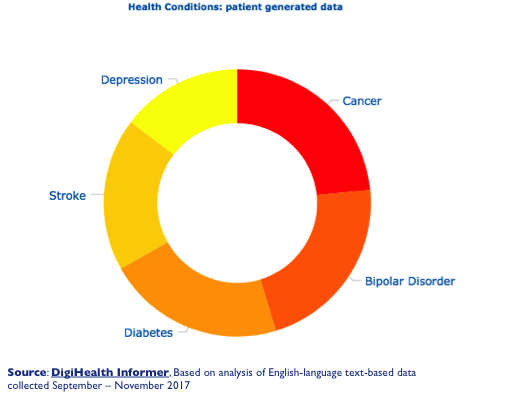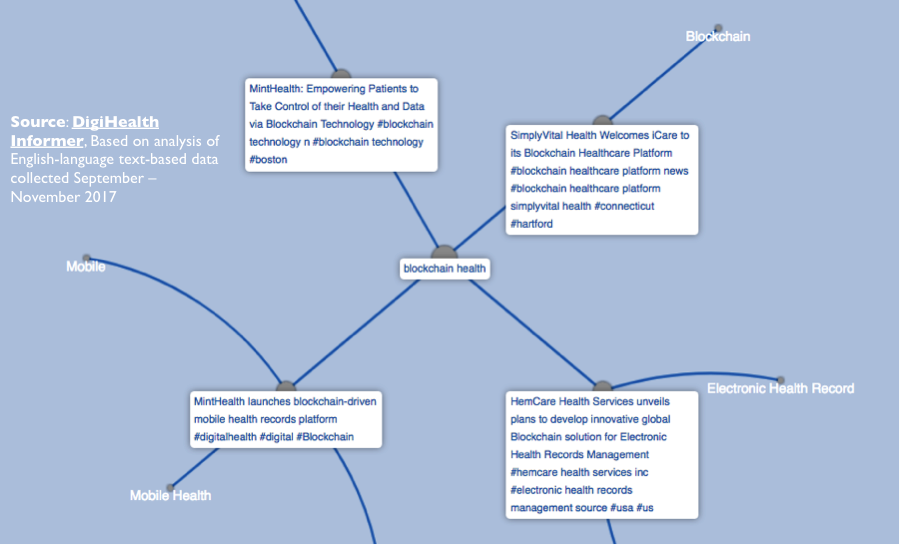
In December 2016, many were suggesting that wearables were dead. Fitbit’s stock price was rapidly dropping. Apple Watch sales had declined for two consecutive quarters and Pebble had just been acquired in a fire sale.
What a difference a year makes. Today, Apple Watch is poised to become the world’s best selling wearable. And, the market is quickly diversifying as hearables (once again led by Apple) and clinical wearables gain importance.
The lesson is clear. As we look toward 2018, it’s more important than ever to focus on the underlying fundamentals of the global digital health market rather than individual technologies that will undoubtedly rise and fall as consumer/enterprise attention waxes and wanes.
To help you focus on the big picture, I present five digital health innovation trends that will matter in 2018, as outlined in the infographic (and explained in detail) below. These trends were identified via examination of our database of 4 million + data points re: digital and emerging technologies and my ongoing analysis of digital health trends for Enspektos’ clients.
1. Policies and Regulations Drive and Threaten Innovation
While the U.S. Food and Drug Administration pushes to speed digital health innovation, uncertainty persists re: the impact of net neutrality’s repeal and the EU’s General Data Protection Regulations.

As the Innovation Map above illustrates, the U.S. Food and Drug Administration made moves in 2017 to provide certainty and a (potentially) more permissive regulatory environment that should help speed digital innovation in the U.S. Because the will be FDA pursuing its digital health innovation action plan in 2018, there is no reason to believe this will change.
However, there are other regulatory and legal headwinds that will cause uncertainty during 2018. The first is the repeal of net neutrality rules, which will give major telecoms more control over how content is distributed and whether companies must pay more to acquire and deliver data and information. Some of the potential negative impacts of net neutrality’s repeal on digital health include:
– Fees for Access to Stored Data Could Increase: Health organizations are already paying fees to store EHR data, and these costs could increase if they are charged higher rates to access this information.
– Remote Patient Management Could Become More Difficult: Patients who need reliable, high-speed Internet for remote monitoring, teleconsults and service delivery could face bottlenecks.
The second issue is the upcoming EU-wide General Data Protection Regulation, which mandates significant changes to how the personal digital data of EU citizens is collected and managed. Importantly, the rules apply even to organizations that are not operating in EU countries — if they collect or have access to the personal data of any EU citizen. There is uncertainty about how individual EU countries will implement the legislation and the Personal Connected Healthcare Alliance fears that “Member States could adopt substantially different rules … leading to a fragmentation … Of the nascent European market in digital health …”
Companies in health technology and digital health should be watching (and planning for) these legal/regulatory issues actively throughout 2018.
2. Patient-Generated Data Comes of Age
The rise of passive biometric and digital tracking technologies, improved data analysis tools and related innovations transform patient-generated data into a high-value resource.
For much of the last decade patient-generated data had a poor reputation. Although many pressed for its integration into health and medical care, lack of confidence about its quality and the difficulties associated with collecting it led to great skepticism and poor adoption.
In recent years, these issues have been addressed with the spread of technologies such as sensors that have made biometric data collection from patient-worn devices and other sources much easier and reliable. Patient-generated data is already playing an increasingly important role in clinical trials and remote patient monitoring and these trends will only accelerate, especially in the disease states outlined in the graph below. (These are areas where patient-generated data has shown great promise, including in mental health (e.g., depression and bipolar) during 2017.

3. Mobile Health = Healthcare
Mobile has become the default technology embedded into tools focused on patient engagement, compliance, clinical trials and other areas. Efforts to improve the vetting and review of mobile applications further drive mobile’s central role in health.
Mobile is one of our most mature and well-studied digital technologies. This has helped it become ubiquitous in health. In 2018 (and beyond), this technology will become so central that it be almost impossible to talk about global health without referencing mobile’s role.
In fact, in some areas, this has already happened. The charts below illustrate three areas where mobile is has been positioned as a central technology in late 2017: diabetes prevention, mental health and adherence/compliance.

4. The Blockchain Health Ecosystem Diversifies
With hospital executives, payers and others considering or deploying blockchain solutions, innovators recognize this technology has great potential in healthcare. Blockchain use cases diversify into anti-counterfeiting, health data marketplaces and other areas.
Thanks to the significant hype surrounding bitcoin and other crypto-currencies, blockchain has received significant attention. And, although many people confuse the two, blockchain is not bitcoin. Blockchain is simply another way to store many types of data — in a highly secure, immutable (write once, read only) fashion.
Just like with relational databases and other data storage systems, many different application layers can be built on top of blockchain — and this is what we’ll see happen increasingly often in healthcare during 2018.
Currently, as depicted in the Innovation Map below, blockchain technologies are enriching everything from mobile health to electronic medical records.

In 2018, we can expect to hear a lot more about blockchain’s role in health-focused artificial intelligence applications, precision medicine and genomics. The chart below illustrates how blockchain innovations have already become associated with these areas of global health.

5. Empathetic Health Interfaces Mature
Advances in artificial intelligence, robotics, the Internet of Voice and related technologies accelerate the development of technologies that are more responsive, empathetic and human-like, which benefits elder care, mental health and other areas.
In my co-authored book, ePatient 2015 (released in 2013), we introduced a concept called empathetic interfaces. Driven by complex programs, we suggested empathetic interfaces would provide patients and others with responsive, intelligent companions that could guide mental health care and play a role in other areas of health.
In 2017, we saw empathetic interfaces make significant leaps forward, as chatbots, robotics and artificial intelligence have led to the creation of truly responsive interfaces that patients are beginning to trust and rely on.
One example of an empathetic interface is Catalia Health’s Mabu, an artificial intelligence and Internet of Voice-powered health companion that delivers patient education, enables data sharing with health providers and could help improve patient adherence and compliance.
In 2018, we will see empathetic interfaces expand across a range of areas, including depression, aging (providing companionship to older adults) and even rehabilitation. The chart below illustrates that these conditions are already closely associated with empathetic interfaces and additional applications of these innovations in these areas and beyond will be developed and introduced throughout 2018.

As suggested by the trends I’ve outlined above, we’ll continue to witness the convergence of technologies and cross-pollination of ideas and innovations across organizations, therapeutic categories, regions and more throughout 2018.
There are bound to be surprises, but it’s extremely likely that we’ll continue to witness the increasing integration of digital health innovations into global health’s DNA over the next 12 months.
Fard Johnmar is a futurist, bestselling author, speaker and strategist. As founder and president of the innovation consultancy Enspektos, Fard focuses on delivering market intelligence, strategic services and research to leading health organizations, innovators, and others globally.
